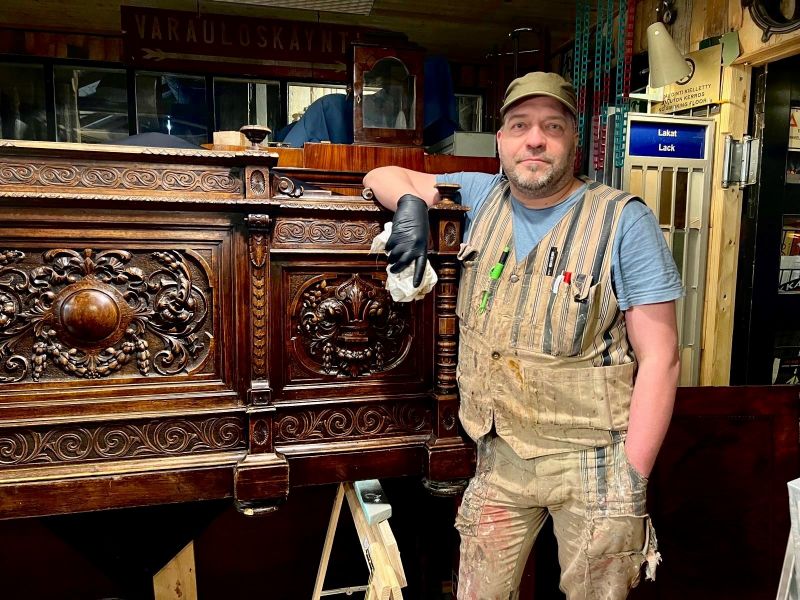Restorer
"A restorer must consider the customer’s needs and the practicality and appearance of the item. Accuracy and interest in details are also required, as it is important to carefully examine the items to be repaired."

- Ville Lampi
- Works as a restorer in their own company, tmi Entisöinti- ja maalaustyöt Ville Lampi.
- Studied the Vocational Qualification in Surface Treatment Technology with an apprenticeship for three years.
- 25 years of work experience in the field.
Briefly explain what you do for a living.
I restore utility, antique and design furniture, i.e. I try to preserve or restore their original appearance and increase their durability. I restore both old antiques and new furniture. In my work, I use almost all substances suitable for treating furniture, such as various oils, waxes and varnishes.
How have you ended up in the profession of your choice?
When I was young, I was long-term unemployed and lost. At the employment office’s career choice meeting, I was asked what I would like to do. My answer was that I didn't know but maybe something with my hands. As a result, I got a work try-out at Pekka Pietilä’s restoration company. I was timid, but Pekka was calm and supportive, which suited me well. After my work training, I studied the field with an apprenticeship, and Pekka suggested that I start my own business. I received start-up grant for starting a business, and Pekka helped me get started by forwarding several work orders from familiar carpenters.
Describe your typical working day or week.
At the beginning of the working week, I plan a schedule so that I can handle urgent work first and all orders progress smoothly. Usually I complete 3–5 different orders per week, and I work on several different projects every day. Some of the work will be completed in a few hours, while others may take several days. I mainly work on base and surface treatment, and I also do varnish, paint and grease removal. I try to complete all work with a specific substance in one go. Brush work, such as painting, varnishing and staining, I usually do at the end of the day.
I work in an old drying barn where I have a paint shop, workshop, warehouse and office space.
What kind of work environment or working hours do you have?
My working days usually last 7–10 hours on weekdays, in addition to which I work 10 hours during the weekend. I've been thinking about having to take one day off in the future, but I'm used to working seven days a week all my life. However, I have recently learned to take occasional days off.
What kind of competence or qualities are required in the profession?
A restorer must consider the customer’s needs and the practicality and appearance of the item. Accuracy and interest in details are also required, as it is important to carefully examine the items to be repaired. Often, it is necessary to closely examine with which techniques and material the item was originally made of, which parts have been repaired and where nails, for example, may be hidden. Restoration work can be slow and requires patience. For example, if I get a rococo chair for restoration, I can work on it for a week. The more energy and enthusiasm you have when working, the better the end result.
What is the best thing about your profession?
Customers often tell fun and interesting stories about the pieces of furniture and their former owners. I like listening to the stories and talking to people. It is rewarding when you achieve a durable end result, and the customer is happy. Over the years, I have gained more professional confidence, which increases the meaningfulness of the work.
Entrepreneurship and crafts really suit me. I like the fact that restoration work doesn’t change quickly. Once you have learned the substances used in furniture in the past 200 years, you know a lot. I also like the fact that, although there are certain rules in restoration, they can be applied, and you can experiment with something new.
What are the downsides of the profession or what seems challenging?
One of the downsides of the profession is exposure to treatment substances and their odours, and some substances cause headache. A full mask makes it difficult to work with precision and breathing with a half mask is hard.
Being a small entrepreneur brings its own challenges, as it is not always possible to take holidays. Sometimes it is difficult for me to stop working in situations where it would be better to rest.
What would you tell a person considering the profession of a restorer?
As an entrepreneur, you can decide what to do and when. The other side, however, is concern about the profitability of the company, as not all days are as productive, and you cannot afford long sick leaves. In addition, you must be available at all times. Sometimes a foreign customer can call in the middle of the night because of the time difference. Nonetheless, I would not like to be an employee, because the feeling of freedom is so important to me.
How do you see the future of your profession?
Artificial intelligence can help in many things, but I do not believe that it will be economically viable in the near future to develop a robot to do restoration work. Automation will certainly play a significant role in the manufacture of new furniture, but restoration requires human creativity, as well as the ability to analyse materials and carry out precise manual work.
I support the circular economy, and it would be important to abandon the throw-away culture. Today, old items are of sentimental value for many and are appreciated more than before.
